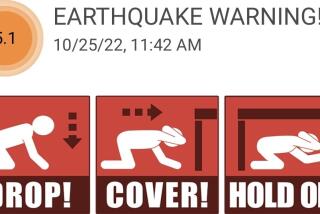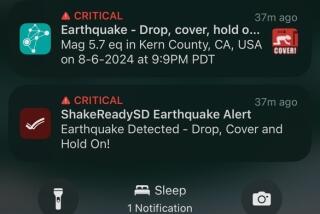Disaster Prompts Calls for Indian Ocean Warning System
- Share via
WASHINGTON — United Nations officials and leaders of some Asian nations Tuesday called for the creation of a tsunami warning system in the Indian Ocean like the one that exists in the Pacific.
Tsunami experts said that while such a network is created, there are low-tech, relatively inexpensive methods to help the region guard against future disasters.
“Had a South Asian regional alert system been in place to warn of the impending tidal wave, many thousands of lives could have been saved,” said Walter Kalin, U.N. Secretary-General Kofi Annan’s representative on the human rights of internally displaced people.
India’s information minister, Dayanidhi Maran, said his country would consider establishing an alert system, and Australian Foreign Minister Alexander Downer said his government would work to create such a system in the region.
The Indian Ocean is not the only sea that lacks protection from tsunamis. The Caribbean and the Mediterranean are also at risk and lack adequate warning systems, officials said.
Efforts to create a warning network probably will be included in a previously scheduled U.N-sponsored meeting next month in Kobe, Japan, U.N. and U.S. officials said.
In addition, the creation of an Earth observation system will be the topic of a February meeting in Brussels that is being led by the U.S. National Oceanic and Atmospheric Administration. The system would be designed to coordinate efforts to monitor natural disasters, weather and environmental developments.
In the meantime, experts said Indian Ocean nations should push ahead with a low-tech solution -- an effort to teach people to protect themselves when an earthquake strikes.
“We need education now,” said Costas Synolakis, a professor of civil engineering at USC, whose lab developed a tsunami warning model used by NOAA.
“If people feel a tremor or the ground shake or see unusual water movements, they should run to high ground and stay there. It’s an extremely simple message, which has been very effective at saving lives in the South Pacific,” he said.
“It hurts me to hear the eyewitness accounts” of Sunday’s tsunami, Synolakis said. “People did exactly what we would hope they wouldn’t.”
In Pacific regions, where tsunamis have been a danger, officials have driven home the message of heading for high ground when an earthquake is felt.
As an example of the effectiveness of that message, Synolakis pointed to a 1999 tsunami that destroyed a village on Vanuatu in the South Pacific. All but three of the village’s 500 residents survived. The villagers had recently seen an educational video about tsunamis and knew to stay away from the beach after feeling tremors.
A high-tech warning system similar to the one established for the Pacific could take several years to develop, according to Synolakis and NOAA officials. The academic estimated that a full-scale worldwide system would cost about $150 million.
It would require buoys anchored to the sea floor that measure wave movements and are capable of sending data, probably via satellite, to a command center.
To accurately predict tsunamis, the command center also would have to receive data from seismographs and tidal gauges, the officials and scientists said.
One or more command centers would have to be set up to relay warnings of approaching tsunamis to countries in the region. And each country would need to develop civil defense or warning systems, such as loudspeakers or sirens, to alert citizens and direct them to evacuate.
“Just putting buoys in the Indian Ocean doesn’t help you,” said Vice Admiral Conrad C. Lautenbacher Jr., NOAA administrator.
“It’s a complicated information-delivery system. That’s why it’s difficult to set up.”
The next phase would be to create maps that identify areas at greatest risk of being inundated so that countries can develop workable evacuation plans.
Scientists are unable to accurately predict earthquakes, and the first warnings of tsunamis come when earthquakes are detected. Depending on how far the epicenter is from shore, killer waves could hit within minutes or hours.
Scientists and NOAA officials said the political will to develop alert systems has been difficult to spark, in part because tsunamis are relatively rare.
“It’s hard to get money for a system that warns you that once every 10 years something bad is going to happen,” Lautenbacher said.
But Helen Wood, a NOAA official who chairs the federal subcommittee on disaster reduction, thinks the current disaster will be a catalyst.
“I believe it will add the ingredient that has been missing so far, and that is commitment,” said Wood, who expects to represent the United States at the U.N. conference.
“The community of world experts needs to seize the opportunity to press for needed action. We cannot recover the lives that were lost, but we can help to make this event lead to benefit for the future.”
More to Read
Sign up for Essential California
The most important California stories and recommendations in your inbox every morning.
You may occasionally receive promotional content from the Los Angeles Times.










